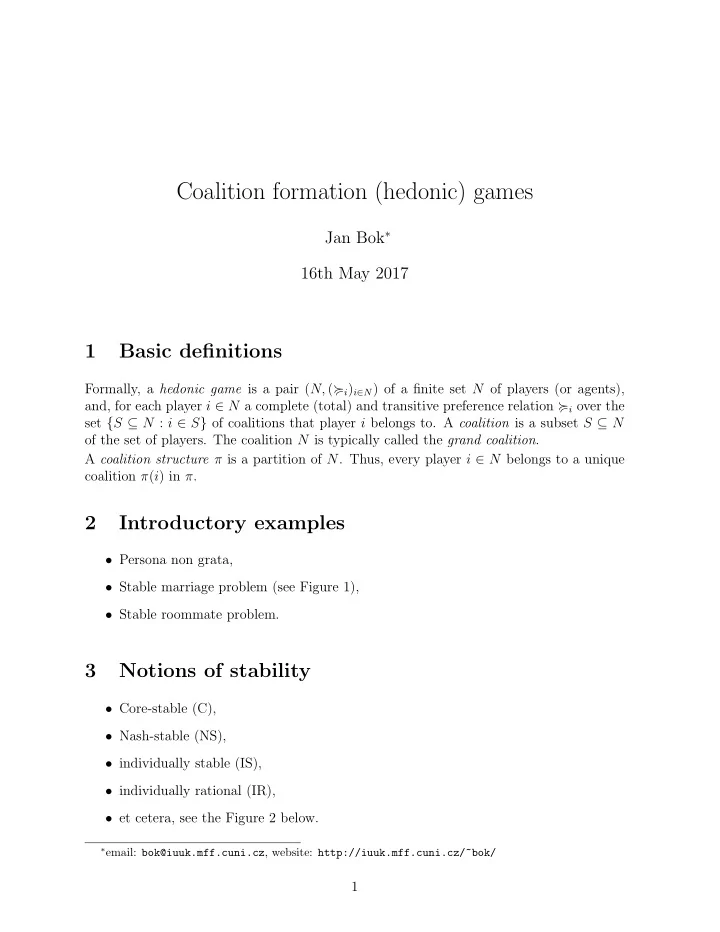

Coalition formation (hedonic) games Jan Bok ∗ 16th May 2017 1 Basic definitions Formally, a hedonic game is a pair ( N, ( � i ) i ∈ N ) of a finite set N of players (or agents), and, for each player i ∈ N a complete (total) and transitive preference relation � i over the set { S ⊆ N : i ∈ S } of coalitions that player i belongs to. A coalition is a subset S ⊆ N of the set of players. The coalition N is typically called the grand coalition . A coalition structure π is a partition of N . Thus, every player i ∈ N belongs to a unique coalition π ( i ) in π . 2 Introductory examples • Persona non grata, • Stable marriage problem (see Figure 1), • Stable roommate problem. 3 Notions of stability • Core-stable (C), • Nash-stable (NS), • individually stable (IS), • individually rational (IR), • et cetera, see the Figure 2 below. ∗ email: bok@iuuk.mff.cuni.cz , website: http://iuuk.mff.cuni.cz/~bok/ 1
4 Exercises Exercise 1. Show that if a partition is NS, then it is IS. Exercise 2. Show that if a partition is IS, then it is IR. Exercise 3. Show that if a partition is C, then it is IR. Exercise 4. For the Persona non grata game decide if the parition P = {{ 1 , 2 } , { 3 }} is core-stable, Nash-stable or individually stable. 5 Restrictions on preferences relation • Additively separable games (see Figure 3 for example), • fractional games, • hedonic coalition nets, • anonymous hedonic games, • individually rational lists of coalitions, • graphical games [4]. 6 Conclusion For more information on hedonic games, see surveys [1, 3] References [1] Aziz, Haris, and Rahul Savani. ”Hedonic games.” Handbook of Computational Social Choice (2016): 136-139. [2] Ballester, Coralio. ”NP-completeness in hedonic games.” Games and Economic Be- havior 49.1 (2004): 1-30. [3] Hajdukov´ a, Jana. ”Coalition formation games: A survey.” International Game Theory Review 8.04 (2006): 613-641. [4] Peters, Dominik. ”Graphical Hedonic Games of Bounded Treewidth.” AAAI. 2016. 2
function stableMatching { Initialize all m in M and w in W to be free while exists free man m who still has a woman w to propose to { w = first woman on m’s list to whom m has not yet proposed if w is free (m, w) become engaged else some pair (m’, w) already exists if w prefers m to m’ m’ becomes free (m, w) become engaged else (m’, w) remain engaged } } Figure 1: Algorithm of Gale & Shapley. (Source: Wikipedia) Figure 2: Hasse diagram of relations between the different notions of stability. [1] 3
Figure 3: This digraph describes an additively separable hedonic game whose core is empty. It has five players (displayed as circled vertices). Any two players not connected by an arc have valuation -1000 for each other. (Source: Wikipedia) 4
Recommend
More recommend